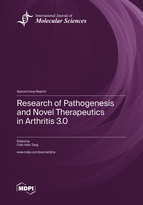Research of Pathogenesis and Novel Therapeutics in Arthritis 3.0
A special issue of International Journal of Molecular Sciences (ISSN 1422-0067). This special issue belongs to the section "Molecular Pathology, Diagnostics, and Therapeutics".
Deadline for manuscript submissions: closed (31 July 2022) | Viewed by 71348
Special Issue Editor
Interests: arthritis; bone cancer; osteoporosis; metastasis; drug development
Special Issues, Collections and Topics in MDPI journals
Special Issue Information
Dear Colleague,
Arthritis has a high prevalence globally and includes over 100 types, the most common of which are rheumatoid arthritis, osteoarthritis, psoriatic arthritis, and inflammatory arthritis. All types of arthritis share common features of disease, including monocyte infiltration, inflammation, synovial swelling, pannus formation, stiffness in the joints and articular cartilage destruction. The exact etiology of arthritis remains unclear, and no cure exists as of yet. Anti-inflammatory drugs (NSAIDs and corticosteroids) are commonly used in the treatment of arthritis. However, these drugs are associated with significant side effects, such as gastric bleeding and an increased risk for heart attack and other cardiovascular problems. It is therefore crucial that we continue to research the pathogenesis of arthritis and seek to discover novel modes of therapy. We invite researchers to submit original research and review articles covering significant developments in the pathogenesis of arthritis, as well as novel medicines or strategies that hold promise in the prevention and/or treatment of this disease. In particular, we welcome research covering novel signaling pathways, signaling molecules, inflammatory cytokines, or anti-inflammatory drugs.
Prof. Dr. Chih-Hsin Tang
Guest Editor
Manuscript Submission Information
Manuscripts should be submitted online at www.mdpi.com by registering and logging in to this website. Once you are registered, click here to go to the submission form. Manuscripts can be submitted until the deadline. All submissions that pass pre-check are peer-reviewed. Accepted papers will be published continuously in the journal (as soon as accepted) and will be listed together on the special issue website. Research articles, review articles as well as short communications are invited. For planned papers, a title and short abstract (about 100 words) can be sent to the Editorial Office for announcement on this website.
Submitted manuscripts should not have been published previously, nor be under consideration for publication elsewhere (except conference proceedings papers). All manuscripts are thoroughly refereed through a single-blind peer-review process. A guide for authors and other relevant information for submission of manuscripts is available on the Instructions for Authors page. International Journal of Molecular Sciences is an international peer-reviewed open access semimonthly journal published by MDPI.
Please visit the Instructions for Authors page before submitting a manuscript. There is an Article Processing Charge (APC) for publication in this open access journal. For details about the APC please see here. Submitted papers should be well formatted and use good English. Authors may use MDPI's English editing service prior to publication or during author revisions.
Keywords
- Arthritis
- Treatment
- Molecular mechanisms
- Inflammatory cytokines
- Prevention







